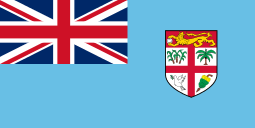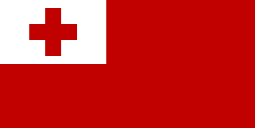Top League
| Top League | |
|---|---|
|
Current season or competition: | |
 | |
| Sport | Rugby union |
| Instituted | 2003 |
| Inaugural season | 2003–04 |
| Number of teams | 16 |
| Country | Japan |
| Champions |
Panasonic Wild Knights (4th title) (2015–16) |
| Most titles | Toshiba Brave Lupus (5 titles) |
| Website | www.top-league.jp |
The Top League is a rugby union competition in Japan. It is the highest level of rugby competition in the country and is an industrial league, where many players are employees of their company and the teams are all owned by major companies. The Japan Rugby Football Union created the competition in 2003, by absorbing the Japan Company Rugby Football Championship, to drive up the overall standard and popularity of the sport and improve the results of the Japan national rugby union team. The first season in 2003–04 featured 12 teams. The league was expanded to 14 teams in 2006–07 and 16 teams in 2013–14.
The chief architect of the league was Hiroaki Shukuzawa who strongly felt the urgency of improving Japanese domestic company rugby to a professional level which would allow Japan to compete more convincingly at Rugby World Cups. Many full-time foreign professionals (mainly from Australia and New Zealand) have played in the Top League, notably Tony Brown and George Gregan. In the 2010s, salaries in the Top League have risen to become some of the highest in the rugby world; in 2012, South Africa's Jaque Fourie, now with Kobe Steel Kobelco Steelers, was widely reported to be the world's highest-paid player.[1]
Developments
- 2014–15: Playoff tournament sponsored as the Lixil Cup.[2]
- 2014–15: Video referee (TMO) decisions introduced for all league games.[2]
- 2013–14: The league was expanded from 14 to 16 teams.
- 2009–10: One of the three foreign players allowed on the field must have played, or be eligible, for Japan.[3]
- 2008–09: Three foreign players per team are allowed on the field at one time, one more than previously. Additionally, one member of an Asian union (such as South Korean Kim Kwang Mo for Sanyo Wild Knights) is permitted to take the field for each team.
- 2008–09: Video referee (TMO) decisions were introduced for the Microsoft Cup play-off tournament.
- 2007–08: A timekeeping system independent of the referee was introduced.
- 2006–07: The league was expanded from 12 to 14 teams.
Second-tier
Provincial leagues at Kantō, Kansai, and Kyūshū regions.
- Kantō: Top East League
- Kansai: Top West League
- Kyūshū: Top Kyūshū League
Seasons
Fourteen teams: 2006 to 2012
Ninth season (2011–12)
NTT Shining Arcs and Yamaha Jubilo which won their 2005 promotion/relegation play-offs (Irekaesen) against Canon Eagles and Kyuden Voltex to retain their places for the 2011–12 season. The following teams were in the league:
The top 4 sides of the regular season (Suntory, Toshiba, Sanyo, and NEC) competed in the 2012 Top League Champions Cup knock-out tournament for the Top League title at Chichibu, Tokyo. Suntory defeated Sanyo 47–28 in the final to win the title. Both teams met again a few weeks later in the final of the 49th All-Japan Rugby Football Championship.
Additionally, in the Wildcard play-offs, the Top League teams ranked 5th and 8th (Kintetsu Liners and Yamaha Jubilo) played each other at Hanazono, Osaka, as did the teams ranked 6th and 7th (Kobe Steelers and Ricoh Black Rams), with the winners (Kobe and Yamaha) also qualifying for the All-Japan Rugby Football Championship.
Eighth season (2010–11)
Honda Heat and Kyuden Voltex were automatically relegated at the completion of the 2009–10 season for finishing 13th and 14th. Toyota Industries Shuttles and NTT Shining Arcs won promotion through the Top Challenge series. The following teams were in the league:
The top 4 sides (Toshiba, Sanyo, Toyota and Suntory) from the regular season competed in a knock out tournament to fight for the Top League title. In the final, Sanyo defeated Suntory 28–23.
Seventh season (2009–10)
IBM Big Blue and Yokogawa Atlastars were automatically relegated at the completion of the 2008–9 season for finishing 13th and 14th. Ricoh and Honda won promotion through the Top Challenge series. Kyuden and Sanix retained their places in Top League when they won their respective promotion and relegation play-offs. The following teams were in the league:
Sixth season (2008–9)
Kintetsu Liners returned to the league, and Yokogawa Denki were promoted for the first time (and renamed Yokogawa Musashino Atlastars in the off season). They replaced Ricoh Black Rams and Mitsubishi Dynaboars. The following teams were in the league:
Fifth season (2007–8)
Kyuden Voltex and Mitsubishi Dynaboars joined the league for the first time. The following 14 teams were in the Top League in the 2007–08 season:
The top four teams (Sanyo, Suntory, Toyota and Toshiba) played in the fifth Microsoft Cup to decide the league champion. Suntory beat Sanyo 14–10 in the final to become the 2007–08 champions. Mitsubishi (14th) and Ricoh (13th) were automatically relegated.
Fourth season (2006–7)
The number of teams was increased from 12 to 14. Coca-Cola West Red Sparks became the second Kyushu-based team in the Top League. IBM returned to the league.
The top four teams in the league played in the Microsoft Cup which was officially integrated into the league from this season as the "Top League Play-off Tournament Microsoft Cup". Toshiba won the cup (and also won the All-Japan Championship. Secom and World (13th and 14th) were automatically relegated, to be replaced by Kyuden Voltex, the third team from Kyushu to enter the league, and Mitsubishi Dynaboars from Kanto.
Twelve teams 2003 to 2006
Third season (2005–6)
After the pre-season 2005 Challenge series, Secom and Sanix returned after a year out of the league, replacing Kintetsu and IBM. The following 12 teams competed in the third season:
Toshiba again won both the league round-robin and the Microsoft Cup knockout competition contested by the top 8 teams after the regular season. Coca-Cola West Japan (now Coca-Cola West Red Sparks) gained promotion to the League at the end of the season. IBM also gained promotion to return to the league.
Second season (2004–5)
Following the 2004 Challenge series with IBM and Toyota being promoted, the following 12 teams competed in the second season:
Toshiba won both the league round-robin and the Microsoft Cup knockout competition contested by the top 8 teams after the regular season. The eleventh and twelfth teams (Kintetsu and IBM) were automatically relegated, and the ninth and tenth placed teams (World and Ricoh) had to win their 2005 promotion and relegation play-offs (Irekaesen) to stay in the Top League, which they did.
First season (2003–4)
The first season began with 12 teams:
Toshiba won the inaugural Top League title by finishing on top of the round-robin competition. The top eight teams qualified for the inaugural Microsoft Cup. Toshiba went on to lose the final of Microsoft Cup to NEC, but the cup was considered a separate competition to the Top League prior to 2007. Secom and Sanix were relegated at the end of the season. IBM and Toyota were promoted.
Champions
Notes:
* NEC Green Rockets won the Microsoft Cup in 2003–04. The Cup was considered a separate competition to the Top League prior to 2007.
Notable foreign players
The following foreign players that have played in the Top League have either won or been nominated for a major IRB award, played in a Rugby World Cup, played for a touring side, or captained their national team.
 Berrick Barnes (2013–)
Berrick Barnes (2013–) – 2007 and 2011 World Cup  Matt Cockbain (2004–06)
Matt Cockbain (2004–06) – 1999 (World Champions) and 2003 World Cup  Israel Folau (2015–)
Israel Folau (2015–) – 2015 World Cup  Bernard Foley (2015–)
Bernard Foley (2015–) – 2015 World Cup  Mark Gerrard (2010–11)
Mark Gerrard (2010–11) – 2003 and 2007 World Cup  George Gregan (2008–11)
George Gregan (2008–11) – 1999 (World Champions), 2003 (Captain) and 2007 (Captain) World Cup  Nathan Grey (2003–11)
Nathan Grey (2003–11) – 1999 (World Champions) and 2003 World Cup  Toutai Kefu (2004–10)
Toutai Kefu (2004–10) – 1999 (World Champions) and 2003 World Cup  Stephen Larkham (2008–11)
Stephen Larkham (2008–11) – 1999 (World Champions), 2003 and 2007 World Cup  Ben McCalman (2015–)
Ben McCalman (2015–) – 2011 and 2015 World Cup  Wycliff Palu (2015–)
Wycliff Palu (2015–) – 2007, 2011 and 2015 World Cup  Joe Roff (2005–06)
Joe Roff (2005–06) – 1999 (World Champions) and 2003 World Cup  George Smith (2011–12)
George Smith (2011–12) – 2001 IRB Player of the Year nominee  Craig Wing (2010–13)
Craig Wing (2010–13) – Australian Rugby League international  Colin Yukes
Colin Yukes – 2003 and 2007 World Cup  James Haskell (2011–12)
James Haskell (2011–12) – 2011 World Cup  Kele Leawere
Kele Leawere – 2003 and 2007 World Cup  Nemani Nadolo
Nemani Nadolo – 2015 World Cup  Marika Vunibaka
Marika Vunibaka – 1999 and 2003 World Cup  Tony Brown
Tony Brown – 1999 World Cup  Jerry Collins
Jerry Collins – 2003 and 2007 World Cup  Rico Gear
Rico Gear – 20-capped New Zealand international  Jerome Kaino
Jerome Kaino – 2011 and 2015 World Cups (World Champions)  Leon MacDonald
Leon MacDonald – 2003 and 2007 World Cup  Ma'a Nonu (2011–12)
Ma'a Nonu (2011–12) – 2003, 2007 and 2011 (World champions)  Glen Osborne
Glen Osborne – 1995 and 1999 World Cup  Reuben Thorne
Reuben Thorne – 1999, 2003 and 2007 World Cup  Sonny Bill Williams (2012)
Sonny Bill Williams (2012) – 2011 (World champions) World Cup  Seilala Mapusua
Seilala Mapusua – 2007 and 2011 World Cup and 2004, 2006 and 2008 Pacific Islanders  Semo Sititi
Semo Sititi – 1999, 2003 and 2007 (Captain) World Cup and 2004, 2006 and 2008 Pacific Islanders  Alesana Tuilagi
Alesana Tuilagi – 2007 and 2011 World Cup and 2006 Pacific Islanders  Thinus Delport (2008–10)
Thinus Delport (2008–10) – 2003 World Cup  Jacque Fourie
Jacque Fourie – 2006 and 2009 IRB Player of the Year nominee  Fourie du Preez (2011–present)
Fourie du Preez (2011–present) – 2007 (World Champions) and 2011 World Cup  Danie Rossouw
Danie Rossouw – 2003, 2007 (World Champions) and 2011 World Cup  Jaco van der Westhuyzen
Jaco van der Westhuyzen – 2003 (Captain) World Cup  Pierre Hola
Pierre Hola – 2003 and 2007 World Cup  Hale T-Pole
Hale T-Pole – 2007 World Cup  Sione Tu'ipulotu
Sione Tu'ipulotu – 1999 and 2007 World Cup  Todd Clever
Todd Clever – 2003, 2007 and 2011 World Cup; current USA captain  Mike Hercus (2008–09)
Mike Hercus (2008–09) – 2003 and 2007 World Cup  Shane Williams
Shane Williams – 2003, 2007, 2011 World Cup and 2005, 2009 and 2013 Lions
See also
References
- ↑ "The 4.25 million pound question". ESPN Scrum. 2012-05-24. Retrieved 2012-05-24.
- 1 2 "Top League to introduce new officiating system this season". Japan Times. 21 August 2014. Archived from the original on 13 January 2015.
- ↑ Daily Yomiuri, 28 February 2008
External links
- Top League awards 2005
- Team Profiles (Japanese)
- Top League official site (Japanese)
- Top League video digest